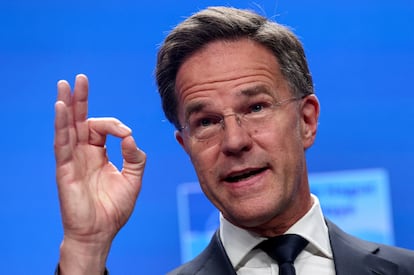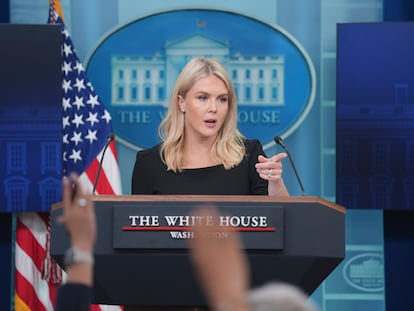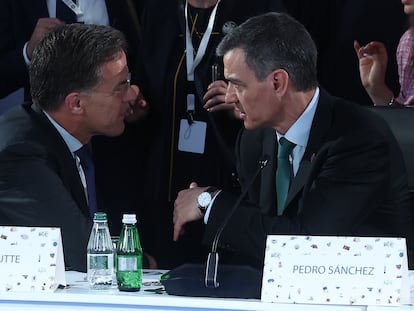NATO holds controversial summit amid 5% spending dispute and uncertainty over the Trump factor
Despite disagreements, the members gathered in The Hague will aim to send Russia the message that the Alliance remains united

There is a consensus among the 32 NATO allies meeting in The Hague on Tuesday: the world has become a much more dangerous place in recent decades. And the Atlantic Alliance, which has ensured the security of its Western members all this time, needs to better protect itself by spending more on defense. This is a shared conclusion, regardless of the specific cost of rearmament — whether it’s 5% of gross domestic product (GDP), as NATO Secretary General Mark Rutte wants, or less, as Spain maintains.
The meeting in The Hague will also seek to overcome the uncertainty generated by one of their own, U.S. President Donald Trump, who has been going his own way on such important issues as Iran, the war in Ukraine, and even his country’s future in the Alliance. From all this, it follows that the gathering in this normally quiet Dutch city will be the most controversial and uncertain one that NATO allies can remember.
The summit, originally meant to last two full days but cut back to accommodate the American president’s impatience, seeks to send Russia the message that, despite obvious ups and downs, the Alliance remains united. And that it will expand its defenses and increase its military spending to discourage Moscow from any attempt to attack — and to discourage Washington from quitting the organization of which it is an irreplaceable pillar.
“As the world becomes more dangerous, Allied leaders will take bold decisions to strengthen our collective defence, making NATO a stronger, a fairer and a more lethal Alliance,” Rutte underscored at a pre-summit news conference. Rutte, a native of The Hague, called the moment “truly historic.”
The final declaration, which has already been negotiated, establishes a commitment to increase defense spending to 5% of national GDP by 2035, split between 3.5% for military investment and 1.5% for infrastructure of all kinds, from roads to communications networks, that could be used for military purposes. It also includes a clause for reviewing spending and defense needs in 2029.
Pressure from Spain, which threatened to break the consensus if it wasn’t allowed sufficient flexibility to decide on the increase in pure military spending—which it believes should be much lower in its case—nearly derailed the success of the summit. Although a solution was finally found through political contortionism, tension over this issue promises to persist until the final family photo in The Hague.
“The fact is that Spain thinks they can achieve those [military capability] targets on a percentage of 2.1%. NATO is absolutely convinced Spain will have to spend 3.5%, to get there,” Rutte said at a press conference on Monday in reply to questions about the “exception for Spain.”
Although the military capability targets agreed upon by defense ministers earlier this month are confidential, Rutte said the goal is a five-fold increase in air defense capabilities—“because we see Russia’s deadly terror from the skies over Ukraine every day, and we must be able to defend ourselves from such attacks”—and to acquire thousands more tanks and armored vehicles, as well as millions of rounds of artillery ammunition as a deterrent.
Shortly before, U.S. Ambassador to NATO Matthew Whitaker had also spoken of a burden that must be demonstrably borne by “every” ally. But Belgium has also made it clear that this is a forced compromise. Although it continues to assert that it will not oppose the 5% threshold, its Deputy Prime Minister and Foreign Minister, Maxime Prévot, has insisted in recent days that his country also needs “maximum flexibility” to achieve a target that he suggested was impractical within the proposed dates. “Belgium’s budget situation will not allow, either in the short or medium term, to reach 3.5% of pure military defense,” he acknowledged in a radio interview.
Despite the U.S. imposition of 5%, NATO—and many of its allies—maintain that the increase in spending, which has even led countries like Germany to undertake a constitutional reform, is justified by the dangerous new international scenario. In this regard, although Rutte’s statement is predictably not as explicit as in previous years—when the White House was not occupied by a president suspected of having too many affinities with the Kremlin—the NATO chief has still made it clear that the most significant and direct threat facing NATO partners is Russia.
Despite this, Ukraine, the main victim of Putin’s imperialist hunger, will have a reduced role in The Hague. Its president, Volodymyr Zelenskiy, has only formally been invited to the gala dinner on Tuesday evening. And the only meeting on Ukraine in The Hague, also on Tuesday afternoon, has been reduced to the ministerial level.
To compensate, Zelenskiy will hold bilateral meetings on the sidelines of the summit, including with Rutte and the presidents of the European Council and Commission, António Costa and Ursula von der Leyen. There are no signs, at least for now, that he will hold a meeting with Trump to compensate for the one the American canceled last week at the G-7 summit in Kananaskis, Canada, after leaving hastily to devise plans to bomb Iran’s nuclear facilities.
Rutte also revealed the figures that allies have pledged in military aid to Ukraine so far this year: €35 billion, almost double the €20 billion pledged in the first three months of the year.
It’s not on the agenda, but one issue will dominate the leaders’ talks: the situation in the Middle East following the U.S. bombing of Iranian nuclear facilities this weekend. In his press conference, Rutte asserted that the U.S. strikes did not violate international law. His remarks came just hours after the U.S. president, in a social media post, appeared to suggest the need for regime change in Iran if it does not abandon its uranium enrichment activities.
Sign up for our weekly newsletter to get more English-language news coverage from EL PAÍS USA Edition
Tu suscripción se está usando en otro dispositivo
¿Quieres añadir otro usuario a tu suscripción?
Si continúas leyendo en este dispositivo, no se podrá leer en el otro.
FlechaTu suscripción se está usando en otro dispositivo y solo puedes acceder a EL PAÍS desde un dispositivo a la vez.
Si quieres compartir tu cuenta, cambia tu suscripción a la modalidad Premium, así podrás añadir otro usuario. Cada uno accederá con su propia cuenta de email, lo que os permitirá personalizar vuestra experiencia en EL PAÍS.
¿Tienes una suscripción de empresa? Accede aquí para contratar más cuentas.
En el caso de no saber quién está usando tu cuenta, te recomendamos cambiar tu contraseña aquí.
Si decides continuar compartiendo tu cuenta, este mensaje se mostrará en tu dispositivo y en el de la otra persona que está usando tu cuenta de forma indefinida, afectando a tu experiencia de lectura. Puedes consultar aquí los términos y condiciones de la suscripción digital.
More information
Archived In
Últimas noticias
Most viewed
- Sinaloa Cartel war is taking its toll on Los Chapitos
- Reinhard Genzel, Nobel laureate in physics: ‘One-minute videos will never give you the truth’
- Oona Chaplin: ‘I told James Cameron that I was living in a treehouse and starting a permaculture project with a friend’
- Why the price of coffee has skyrocketed: from Brazilian plantations to specialty coffee houses
- David King, chemist: ‘There are scientists studying how to cool the planet; nobody should stop these experiments from happening’










































